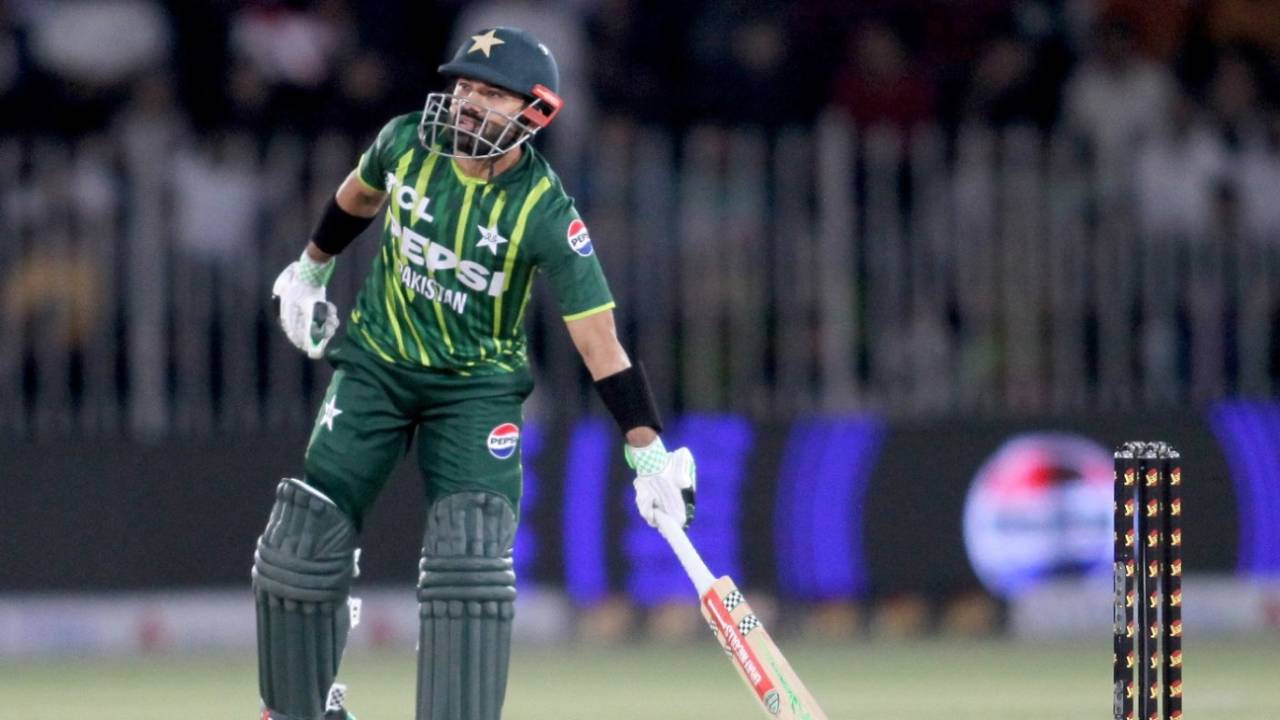Are Pakistan stuck in a T20 time warp?
As records are gutted in the IPL, they continue to be hampered by the fear of losing powerplay wickets
Osman Samiuddin
30-Apr-2024
Mohammad Rizwan and Babar Azam make for two anchors in Pakistan's T20I top order, which is about one too many • PCB
178.
One hundred and seventy-eight: welcome, Gary Kirsten, to Pakistan's T20 world.
Twice in the recently concluded series with New Zealand, Pakistan scored 178. Once they scored 174. Of those, they lost two and won one. In three of the five T20Is Pakistan played in New Zealand earlier this year, they made 180, 173 and 179. They lost all three.
One hundred and seventy-eight: it's not the score, per se, that is a problem, more what it signifies. It appears about the height of Pakistan's aspirations, as evidenced by captain Babar Azam's fairly specific breakdown of how he wants their innings to play out. Fifty-plus in the powerplay, another 40 by the 10th, 90-100 in the last 10: 180-190 all told.
Simultaneously, though, 178 feels like a weight around their feet, amplified no doubt by this hallucinatory IPL season. On the day he was announced as Pakistan's coach, Kirsten oversaw his Gujarat Titans side put 200 on the board. He then watched Royal Challengers Bengaluru chase it with nine wickets in hand. Also: four overs to spare. Four! The game before, Gujarat ended one hit short of chasing 225.
Last Friday, Kirsten saw Punjab Kings blitz down a target of 262. Sunrisers Hyderabad nearly clocked 300, and RCB weren't far from chasing it. The world is wondering whether this is an outlier season, or the first of the rest of our T20 lives. Pakistan, meanwhile, are scoring 178.
Of course, this is an unfair comparison. Franchise cricket is almost a different format from T20I bilateral cricket; in the former, personnel are dictated by market forces not geography. Surfaces differ. Now even the number of players a team is allowed differs.
But Pakistan's lack of intent oomph, especially when batting first, is such a longstanding issue it has morphed into a culture-war flashpoint, data heads on one side against the world on the other. To Pakistan's credit, they have tried to do something about it, bringing in Saim Ayub to open. That has broken up the Babar-Mohammad Rizwan opening pairing, hitherto the boon and bane of Pakistan's approach. Ayub has been in nine of their last ten XIs, and despite not replicating his PSL game (but surely, he will) was given very public backing by both captain and interim coach after this series.
Except, it's not really been a break-up. In New Zealand, Rizwan partnered Ayub at the top with Babar at three; in Pakistan, Babar opened and Rizwan went to three. Bottom line: Pakistan are still playing two anchors (strike rates 129-ish) in their top order, which is - or should be - a T20 no-no. Ayub may stay in the XI, but nobody would be surprised if it was not as opener, allowing a Babar-Rizwan reunion.
Because ultimately, as Babar made clear after the final New Zealand game, they're still worried about losing too many wickets in the powerplay. Which, to be honest, is what is most passé about this. Not so much the totals as the fear of losing wickets, which, as has become abundantly clear, is precisely what batters are shedding in the format.
Kirsten is a wise coach, though. He'll know that despite this, Pakistan are one of three teams to have made at least the last four of the last two T20 World Cups, in vastly different conditions. He'll know that the batting we've seen at the IPL will not necessarily be replicated in this T20 World Cup. He'll know it's too late for radical change right now.
But he must know that time is coming.
Osman Samiuddin is a senior editor at ESPNcricinfo
